![]()
![]()
![]()
Use LEFT and RIGHT arrow keys to navigate between flashcards;
Use UP and DOWN arrow keys to flip the card;
H to show hint;
A reads text to speech;
47 Cards in this Set
- Front
- Back
|
Scoliosis
|
An abnormal lateral curvature of the spine in the coronal plane. Scoliosis (rotoscoliosis) is an abnormal sidebending accompanied by rotation.
|
|
|
Type I mechanics:
|
Describes multiple vertebral units. Sidebending to one side will be accompanied by rotation to the opposite side.
NSxRy |
|
|
A scoliotic curve is always named for the direction of the _____.
|
CONVEXITY
|
|
|
Double Major Scoliosis
|
Most common type. An apex in both thoracic & lumbar spine.
“S”-shaped curve |
|
|
Single Scoliosis
|
An apex in the thoracic OR lumbar spine
|
|
|
Junctional Scoliosis
|
Uncommon. An apex at either the cervicothoracic (C7-T1) or thoracolumbar (T12 -L1) junction.
|
|
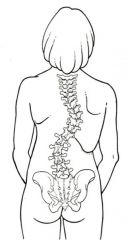
What type of scoliosis is this?
|
double major
|
|
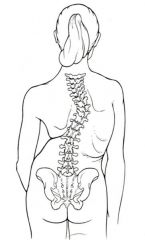
What type of scoliosis is this?
|
right thoracic
|
|
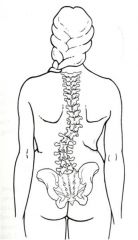
What type of scoliosis is this?
|
left lumbar
|
|
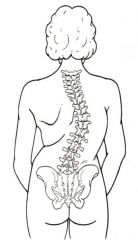
What type of scoliosis is this?
|
right thoracolumbar
|
|
|
Idiopathic scoliosis
|
70-90% of scoliotic curves are in this category. Adolescent idiopathic scoliosis (10-18 years old) is the most common. Diagnosis of exclusion. Unknown cause
|
|
|
1 in every ___ children develop scoliosis by the age of 10-15 years.1 in every ___ children present with clinical symptoms related to their curvatures.
|
20, 200
|
|
|
Are boys or girls more likely to have scoliotic symptoms progress and produce symptoms?
|
girls, 3-5 times more likely
|
|
|
Acquired scoliosis
|
-Response to inflammation or irradiation
-Osteomalacia -Sciatic irritability -Psoas syndrome -Healed leg fracture -Hip or knee prosthesis |
|
|
Which curves have higher risk for progression, thoracic or lumbar?
|
thoracic
|
|
|
_____ sign (ossification of iliac crest on x-ray) determines bone maturity.
. |
Risser
|
|
|
Functional Scoliosis
|
Flexible, and potentially reversible. Reducible with sidebending to the opposite side. May progress into a structural scoliosis.
|
|
|
Structural Scoliosis
|
Relatively fixed and inflexible.
Non-reducible with sidebending to the opposite side or lift therapy. |
|
|
_____ syndrome is the most common cause of Type I group curve mechanics.
|
Short Leg Syndrome
|
|
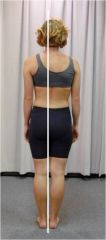
In a static postural exam, levelness should be observed for: (6 items)
|

1. Popliteal creases
2. Greater trochanters 3. Iliac crests 4. Scapular inferior angles 5. Acromion processes 6. Mastoid processes |
|
|
Adam's Test
|
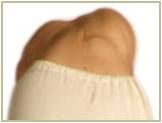
"hump" becomes apparent w/ forward flexion; vertebral rotation carries ribs w/ rotation.
|
|
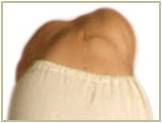
What type of scoliosis does this patient have?
|
right scoliosis
|
|
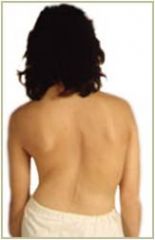
Which side is the convexity on?
|

right side convexity; scoliosis named for CONVEXITY!
|
|
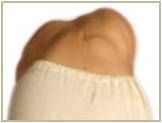
To which side is the patient sidebent and rotated?
|

sidebent Left, rotated Right
|
|
|
Adam's Test: If Pt has a rib hump present w/ flexion, direct the Pt to...
|
bend to the side of fullness while flexed.
|
|
|
Adam's Test: If Pt has a rib hump present w/ flexion that diminishes or disappears w/ Pt sidebent toward convexity, it is a _____ scoliosis.
|
functional; structural scoliotic curves do not reduce with with sidebending towards convexity.
|
|
|
When are X-rays appropriate in scoliosis screening?
|
-Static postural exam abnormality
-Adams test confirms structural scoliosis -OMT not entirely successful -Congenital abnormality suspected -Monitor progress of postural treatment regimen |
|
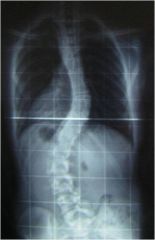
Which side is closest to film, anterior or posterior?
|

posterior; Erect AP postural radiograph
|
|
|
Cobb Angle
|
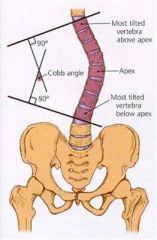
Erect AP postural radiograph used to measure severity:
-Line across top of superior vertebra -Line across bottom of inferior vertebra -Perpendicular lines off both lines -Angle of intersection is the Cobb angle |
|
|
Mild Scoliosis
|
5-15 ̊
|
|
|
Moderate Scoliosis
|
20-45 ̊
|
|
|
Severe Scoliosis
|
>50 ̊
|
|
|
Impaired Respiratory Function
|
>50 ̊
|
|
|
Impaired Cardiovascular Function
|
>75 ̊
|
|
|
Lumbosacral Angle (LSA) / Ferguson's Angle
|
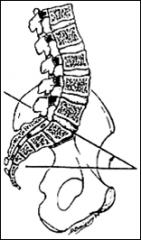
Angle between line from sacral base to line parallel to the ground
|
|
|
A lumbosacral angle >40 degrees may result in:
|
-Increased lumbar lordosis and extension (sway back)
-Shearing forces on intervertebral discs |
|
|
A lumbosacral angle <30 degrees may result in:
|
-Decreased lumbar lordosis (flat back)
-Compressive forces on articular facets |
|
|
When is MRI indicated?
|
If you suspect an underlying neurological disorder (ie: focal neurological deficit on clinical neurological exam) as the etiology of the scoliosis, MRI imaging of the brain is indicated.
|
|
|
Arnold-Chiari Malformation
|
brain stem settling into the neck and its associated syrinx (spinal fluid cyst)
|
|
|
Schroth exercise:
|
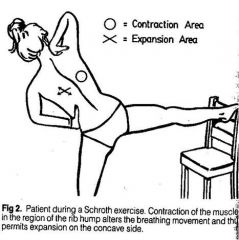
-Physiotherapeutic rehabilitation popular in Europe
-Also focuses on rotational breathing exercises and integration of exercise in daily life |
|
|
Schroth breathing pattern:
|
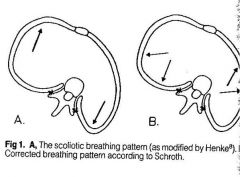
|
|
|
What is the initial and increase heel lift protocols for a Flexible Pt?
|
intial: 1/8" lift; increase every 2 weeks NO MORE than 1/16"
|
|
|
What is the initial and increase heel lift protocols for a Fragile Pt? (aged, arthritis, osteoporosis, acute pain)
|
initial: 1/16" lift; increase every 2 weeks NO MORE than 1/16"
|
|
|
What is the initial and increase heel lift protocols for an Injured Pt? (Where leg length was suddenly shortened)
|
initial: Full amount; no increase protocol indicated
|
|
|
Thicker heel lifts may need to be applied to the _____ of the shoe in some cases.
|
outside
|
|
|
Moderate-Severe scoliosis Tx:
|
-Moderate: same as Mild plus consider bracing
-Severe: same as Moderate plus consider surgery if visceral compromise or rapidly progressive curve despite conservative management |
|
|
Harrington Rod
|
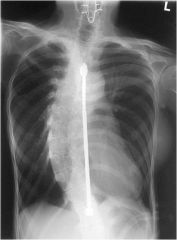
utilizes Axial loading; accompanied by bone grafts
|

